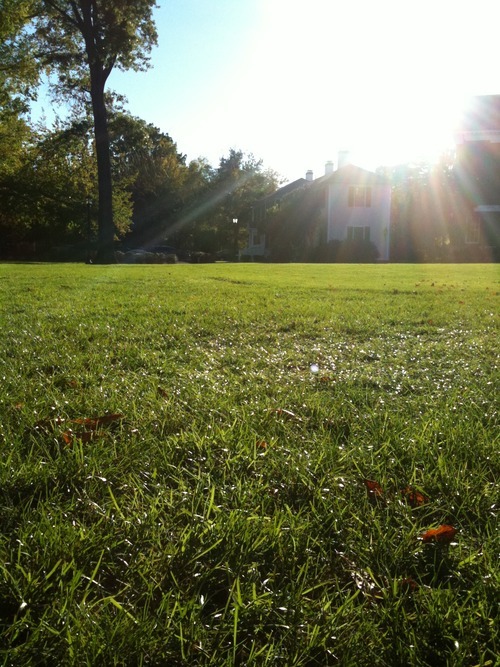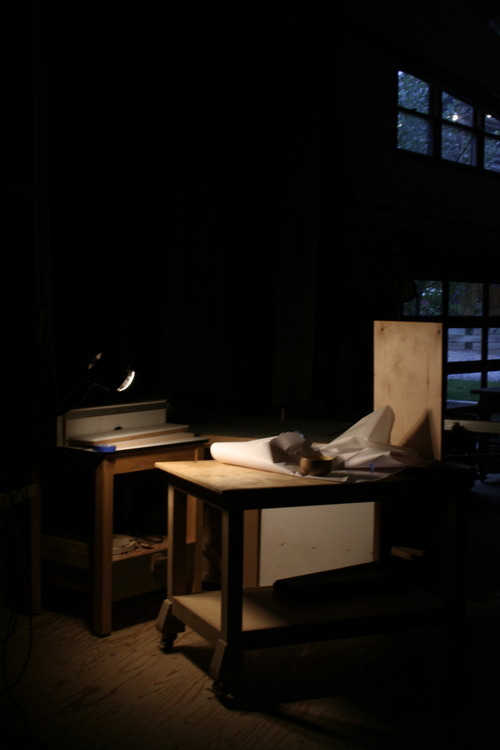
early evening, late august 2008, snowmass. everyone else had left for a much-needed break at the end of the summer.
Oct 28, 2010
maloof studio, anderson ranch
Posted by
vaughn tan
0
comments
![]()
![]()
Labels: arac
Oct 27, 2010
thinking makes it so
there is no good or bad material, what makes the difference is its right and adequate use.
willy guhl
Posted by
vaughn tan
0
comments
![]()
![]()
cold salad for a hot planet

august 10, 2010. RH 89%, 94F.
Posted by
vaughn tan
0
comments
![]()
![]()
Labels: food
food at 24 frames per second

the people behind the magic.
Posted by
vaughn tan
0
comments
![]()
![]()
Labels: food
Oct 26, 2010
temperature series
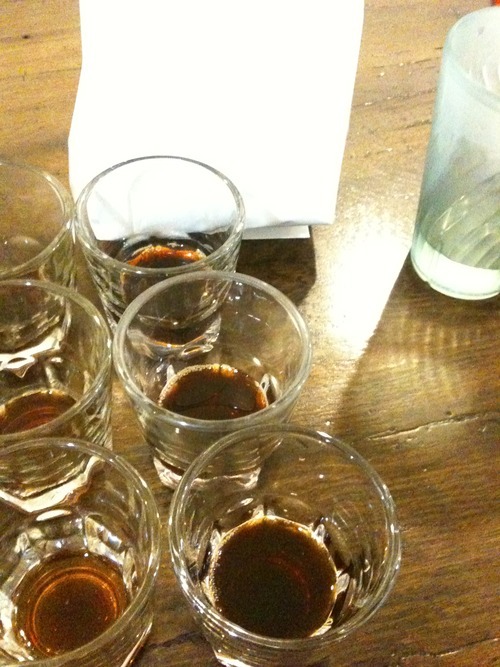
same dose, same grind, four temperatures. thank you jamie, thank you barismo.
Posted by
vaughn tan
0
comments
![]()
![]()
Labels: coffee
gs3
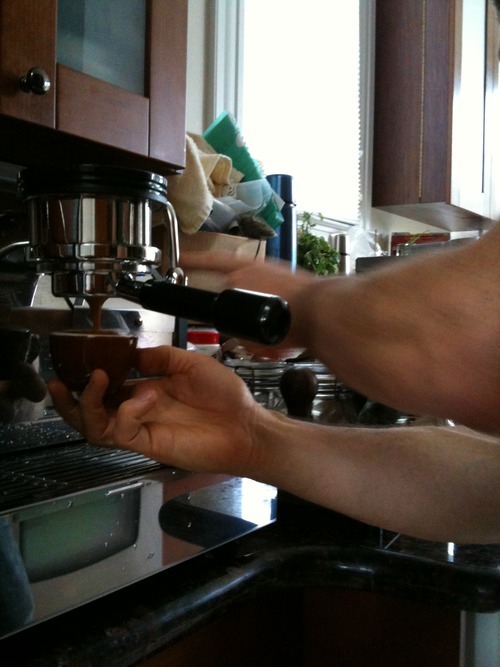
dan pulls a great shot of friendo blendo on a shiny new gs3 with a naked portafilter. in back, you see a versalab grinder, which is also very nice.
Posted by
vaughn tan
0
comments
![]()
![]()
Labels: art, coffee, craft, execution success, san francisco
Oct 21, 2010
environmental sensing
the distributed cognition reading group forges on this week, into donald hoffman's visual intelligence, which stilgoe assigned years ago. now slightly dated, it presents a shortish list of rubrics the mind follows for interpreting optical information acquired from the world without. the point of the book is to convince the reader that vision is both more cognitively involved than it seems and yet also reducible to simpler rules than might at first appear to be the case. it succeeds on both counts.
i liked the book when I first read it mostly because it presented a vast quantity of research in an almost patronisingly accessible fashion. the 34 (i think i'm close) rules of visual image processing were also stunning because i hadn't thought about this stuff prior to reading about it in hoffman and seeing his accompanying illustrations, each designed to highlight the particular rule being discussed. revisiting the book, my original impression of the care taken in writing it remains unchanged. it's science writing of rare quality. the power of the illustrations and the systematic presentation of the rules of visual image processing is diminished somewhat by greater familiarity with the subject matter, but not by much.
my quibbles this time around are with underlying assumptions. most of these are not, in the grand scheme, very important. the one which is worth mentioning is the question of where these rules of visual intelligence come from to start with. hoffman goes on a brief chomsky lovefest some way into the book, and argues that there is something innate about these rules. the argument for innateness (or hardwiring, or whatever) is that the rules are non-obvious, they emerge at a young age, and are almost universal. this argument seems incomplete. perhaps this is because i have, lets face it, no training in the cognitive sciences. but for counterargument's sake, here's another explanation.
a quick survey of the rules leads to the overwhelming conclusion that they are designed to be as parsimonious as possible in terms of cognitive processing. the constraint imposed by the laws of physics produces patterning and regularity in the behaviour of physical objects in the environment as perceived visually. we are pattern-seeking and pattern-identifying beings, and we find patterns in things especially quickly when the patterns are frequently repeated. the ubiquity of the rules of visual information processing therefore plausibly reflects the ubiquity of physical laws rather than innate hardwiring.
(this is not to say that thousands of years of evolution have not produced neural pathways optimized to process these particular types of regularities and patterns, but only to suggest that there may be an antecedent cause for this kind of hardwiring.)
hoffman's conclusion went unappreciated by me when i first read it but not this time around. he notes that the world we perceive is both the world we have interpreted through vision (the phenomenal world) and the world as it "really is" (the relational world). as long as the relational world is systematic in its behaviour, it is possible to interpret what we perceive of it. importantly, the relational world can be completely arbitrary, as long as it is systematic. this is deep stuff, at least to me, for what it contributes to sociological understanding: it goes some way to providing a theoretical basis for understanding why practices that seem totally alien to me can be accepted as norms by someone else in a society where those practices are normal.
clay shirky gave a talk to a small number of people at HBS a few weeks ago about his new book. during the talk, he made much about cultural values and norms, but never defined culture. i brought that up in the Q&A and he instantly gave one of the crispest and best definitions of culture i've heard yet: "culture is the set of habits that allow a group of people to cooperate by assumption rather than by negotiation." i would extend and improve on it and say culture is the set of habits that allow a collectivity to coordinate by assumption rather than by negotiation."
the fact is that we are environment-sensing entities. when we see that the environment is chaotic, our instinct is to keep paying as much attention to it as we can, in as fine-grained as manner as we can, until we can detect a pattern. we are also economical (lazy, if you prefer) so that, if that pattern holds and is detectably stable, we then identify the rule producing the pattern, and use it to reduce attention on that phenomenon to an algorithm and devote our freed-up attention capacity to something else. in doing this, we form habits: sets of rules of cause and effect, sequences of things we do because doing them in the past produced a result that we wanted to recur.
when we act in the world, we combine both the phenomenal world (our perception of the world) and the relational world (the "real" world that responds to our actions). we develop habits by understanding the relationship between action and the behaviour of the relational world in response to action, as mediated through perception. (this can be said, now i think of it, even for how we develop habits for things like scratching a scab. if you haven't tried this, know that it feels really good.) in other words, we develop habits when we identify patterns in how our phenomenal world changes as the relational world responds to the actions we perceive ourselves taking in the relational world.
under all this is the assumption that humans are experimental beings: much of how we act comes from learning how to act in a real world that we perceive as responding to our actions. this is what frustrates me about our continuing obsession with strategy (formal and rational rules) where the really interesting stuff seems to be happening in tactics (practical reason responding to an environment with the resources at hand).
where is the research program on practical reason?
Posted by
vaughn tan
0
comments
![]()
![]()
Oct 13, 2010
Oct 10, 2010
three states of hors d'oeuvres
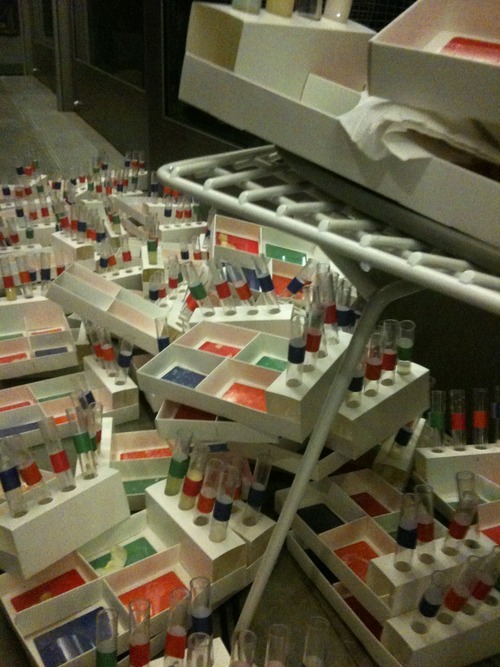
the project on spatial sciences was at the lab's re-launch. lots of fancypants people swarmed the northwest building to kick a soccerball around the basement (really) and eat a light repast upstairs. the idea: eat something solid, drink something liquid, while inhaling an aromatic vapour. in theory, intentional synaesthesia. in practice, the aroma of bonito flakes and sunkist orange juice permeating throughout. negative pressure in the vapour booths would probably help considerably. as would better flavourants and a disposal plan for the waste from the hors d'oeuvres (seen above forming large drifts piled up against the windows).
Posted by
vaughn tan
0
comments
![]()
![]()
Labels: art, cambridge, food, sustainability
Oct 7, 2010
cooking with fire and clay
L-R bottom row: some rocks, bricks.
michael pollan is such hot shit, cooking mindblowingly delicious multicourse collabo meals over the span of more than a day with nothing more than an enormous wood-fired oven, a bevy of experienced baker-folk and chef-types*, apparently vast quantities of local seasonal produce and carefully raised meats, specialty equipment (including a real, live salamander, shown here to great advantage hovering above apricot and saffron gratin), and untrammeled access to a palatial country estate in napa, calif.
caitlin's fieldwork brings her often to bolivia from whence she has, over the course of several visits, amassed a sizeable collection of clay pots and other cooking apparatus in which she now does most of her cooking. she returned from her latest excursion with a bolivian wood stove which is elegant in its absolute simplicity. this object, which you see in the photograph above, inspired chris and caitlin to convene us for a saturday afternoon exercise in atavism: to return to the humans that we all were in the dark backward and abysm of time by cooking a meal with fire and clay. i pointed out to chris that since we usually do most of our cooking over fire it wouldn't truly be atavistic without the clay.
our interdependent cooking configuration:
- clay pots, wood stove, and mad cooking skillz from caitlin;
- more mad cooking skillz, lamb shoulder, plus general aura of cool from max (who makes music, works for the food project, and surfs);
- bricks, firewood, and knowing commentary from chris;
- big talk and giant scarlet runner beans from mexico by way of steve sando (by way of me).
an open question: the stove was painted bright red to start and then turned black right after the fire got lit. will chris and max die tragically young, their promise unfulfilled because of toxic fumes inhaled while lighting a fire in a bolivian wood stove? only time will tell. but before describing what went down in each of the pots, let's backtrack an hour or so before the lighting of the fire, to when we cheated slightly by using the gas stove to boil gallons of water, brown many pieces of lamb in a cast iron skillet, fry up onions for the beans, and set off the smoke detectors for the entire building. to caitlin's landlady and her numerous neighbours, we say "sorry!"
- once properly seasoned and cured, you cook with clay pots just like you would with metal ones.
- conductivity in clay is much lower than in metal, so a variable heat source is much less problematic than you think. clay and wood are built for each other.
- food cooked in clay tastes earthy, in a good way. earthy food is both not new and also quite new.
- no clue about comparative heat capacity and thermal mass.
- heat control on this little stove thing (accomplished by pushing in or pulling out flaming pieces of wood) is surprisingly good.
- they took 36 hours to cook their meal; we took 5.
- they were in napa, calif.; we were in somerville, mass.
- they used a custom-built wood-fired oven; we used a bolivian peasant woodstove.
- they made a massively multicourse meal featuring many brightly coloured food items; we made beans and a lamb stew, both of which were brown with brown highlights, though the garnishes did feature green and red bits.
- they cooked meat raised with care; we cooked meat raised with care by someone we know.
- "never once [did they have] to run out to the store for a missing ingredient"; we did two separate runs for garlic, dried aji amarillos, onions, tea, sugar, limes, and a taco for max.
I realize I’ve gotten at least as much pleasure from working together to create these meals as I have from eating them. Sometimes producing things is more gratifying—and more conducive to building community—than consuming them, I decide. ... there’s something special about the camaraderie of the kitchen crew.
Posted by
vaughn tan
0
comments
![]()
![]()
Labels: execution success, food, sour grapes, technology
Oct 5, 2010
dishwasher x keyboard
verdict = clean and fully functional, after 6 days of air-drying. naysayers and debbie-downers = 0, the internets = 1. though tempting, this cleaning procedure is not recommended for notebook computers. some notes:
- remove as much of the casing as you can, and the usb cable too.
- top rack only.
- no rinse agent.
- take keyboard out periodically during cycle and flush keys with hot running water. a remarkable amount of crud builds up inside and under.
- remove before dry cycle begins.
- rinse thoroughly under hot running water to remove detergent traces.
- allow to dry under direct, hot sun for as long as you can bear it before reassembling.
Posted by
vaughn tan
0
comments
![]()
![]()
Labels: execution success, instruction

